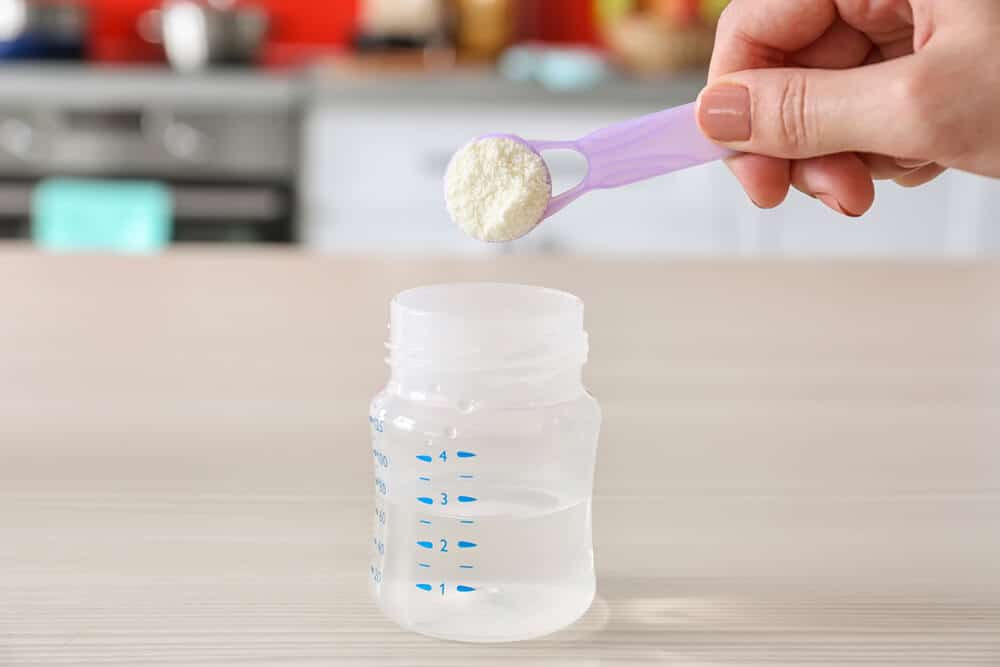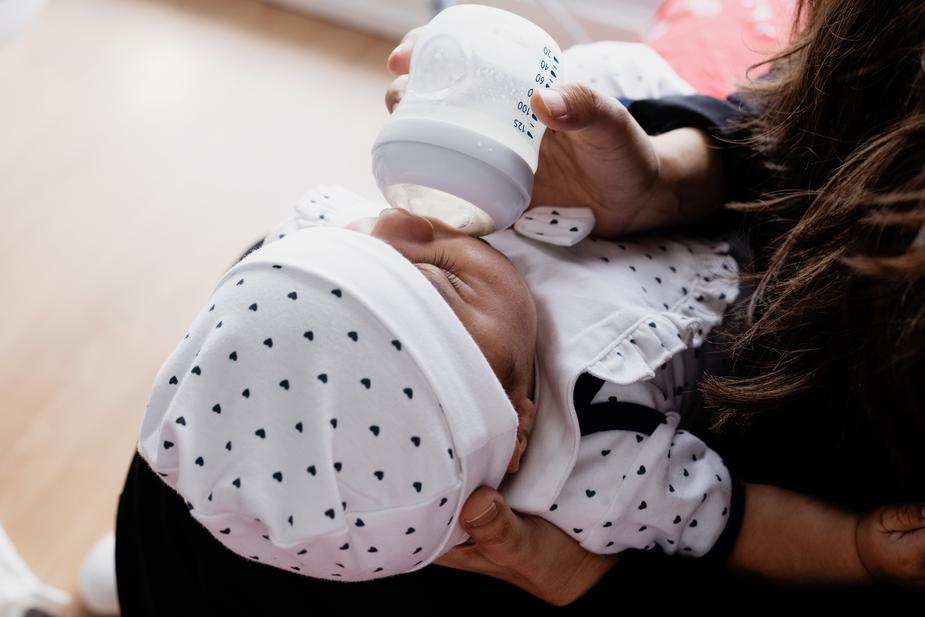There are so many things to consider when feeding your baby, its a pretty big deal. So much of your baby’s days pretty much revolve around sleeping and eating in the beginning.
I wanted to share my favorite formula feeding tips and tricks that will save your sanity and time. These tips are so simple but will change your approach to formula feeding.
This advice will make formula feeding easy, help you get organized and you will spend less time cleaning bottles!

Formula Feeding Guidelines
First, you’re probably wondering how often should a formula fed baby eat? It’s easy to wonder if you’re feeding your baby too much or too little because it’s not like they can tell you.
Here are some general formula feeding guidelines for you to follow. Remember, as you get used to your baby’s eating habits, these can be adjusted. You will soon learn your baby’s cues to know if they are hungry or if they’ve had enough.
Newborns
- 1-3 oz every 2-3 hours
2-4 Months
- 4-6 oz every 4-5 hours
6 Months and Older
- 6-8 oz every 4 to 6 hours
7 Bottle Feeding Tips You Need To Know

1. Pick Your Formula and Stick With It
Once you know what type of formula your baby likes and doesn’t have any bad reactions to, stick with that one. Babies stomachs can’t handle the constant changing of their formula.
Switching formulas abruptly can cause gas, constipation, diarrhea, fussiness, and discomfort for your little one. When you find the formula that works, you should consider stocking up on it.
Sign up for the manufacturer’s email list to see if they send coupons or samples in the mail. In my personal experience, I got monthly coupons from big brands like Similac and Enfamil by signing up for their lists. Every bit helps!
Don’t forget to see if your baby’s pediatrician office has samples of the formula.
2. Use One Brand Of Bottles and Pay Attention to Bottle Nipples
Just like sticking to the same type of formula is a great idea for your baby, using one type of bottle makes life easier for you and baby!
You can use all pieces interchangeably and you won’t have to worry about mismatching nipples or other bottle pieces.
For example, Dr. Brown’s bottles have a LOT of pieces to clean. They do not play well with any other bottles. We used those for the first few months of my daughter’s life but I instantly felt the whole bottle process got easier when she switched to Comotomo bottles that didn’t have any extra pieces.

Pay attention to the nipple stages, they control the flow of milk based on the baby’s age. When they’re younger, you don’t want the milk flow to be too fast. When they get older, a super slow flow nipple might frustrate them.

3. Water and Warming Your Baby’s Bottles
As a new mom and new to formula feeding, in the beginning, I wondered “Do I really have to boil water for formula?”
According to Verywell, If your water is from a safe source and you do not have concerns about contamination of the water supply, then you can proceed without boiling. Contact your local health department if you are concerned or want to know more about the safety of your water.
Giving your baby warmed formula bottles is a choice completely up to you! I preferred to give my baby warm milk.
Read more at ‘What Age Can Babies Drink Cold Formula?‘ and whether it’s a viable shortcut.
Once you start doing that you face a dilemma of how to warm your baby’s bottle on the go.
You might have the best baby bottle warmer and it works fantastic at home, but while you’re out and about you need something to warm milk without a power source.
This on the go baby bottle warmer is perfect for those times. It’s compact and the lid is very secure so you don’t get any leaks in your baby’s diaper bag.

4. Pace Feeding Is Your Friend
I had honestly never heard of pace feeding before I started bottle feeding a baby. Once I found out what it was though, it made all the sense in the world.
Pace feeding your bottle feed baby mimics the flow of the milk like breastfeeding would. It slows the flow of milk and allows the baby to bottle feed more comfortably.
It involves feeding your baby with a bottle that has a slow flow nipple, sitting them upright instead of laying all the way back and allowing them to take breaks. Another formula feeding must have is a nursing pillow to help you position baby, it works well for bottle feeding too!

Check out this video for a demonstration of pace feeding. Seeing it in action might help it make more sense.
5. Get very acquainted with burping and baby gas
When I was learning how to survive the newborn stage, I didn’t know just how big a deal baby burping was but I learned very quickly!
Hearing a burp or belch is usually not something to look forward to, but when you have a tiny baby that can’t do it on their own, it is the best sound!
Gas bubbles can become trapped in your baby’s belly and it’s no fun for them or you.
Formula feeding babies need to take breaks while bottle feeding. Every 2-3 ounces, make sure to burp your baby.
Bottle fed babies will swallow air while drinking. Use these natural remedies for newborn gas relief to relieve your baby and help them release those gas bubbles. You will figure out your favorite go to burping position!
6. Be Prepared For On The Go Feeding
You will have to leave the house and some point, whether it is to go grocery shopping or some other reason. Baby’s still gotta eat!
Since prepared formula bottles cannot sit out unrefrigerated for long periods of time, you need to know what to pack in your diaper bag for on the go feeding.

A formula feeding must have is a formula dispenser and its the best way to travel. You can put the exact amount of formula you need for your baby’s bottles in each divided section.
That is way easier than trying to fumble around with a scoop and measure out the right amount of formula when your baby is hungry right NOW.
The cool thing about this formula dispenser is that when you’re done with formula, it doubles as a snack cup. Just remove the divider insert!
7. Preparation and Creating A Bottle Station

Have you figured out that you spend most of your time bottle feeding, washing, rinse and repeat? It really does seem like an endless cycle in those early days.
I cant tell that you won’t be washing bottles for the foreseeable future, but I can tell you how to make the task a little bit easier.
Get enough bottles to last throughout the whole day. Once your baby uses one bottle, try to take it apart and put it in the dishwasher immediately.
Did you know there are special dishwasher baskets that hold all the bottle pieces so you can keep nipples, collars, valves, etc in one place and not all over the dishwasher? Once I discovered those, washing bottles became much easier.

At the end of the day, make sure to run the dishwasher or have someone in your household start it.
As with most things, being prepared makes bottle feeding a bit easier. Mix up your baby’s formula for the whole day in a formula pitcher. I used this one from Dr. Brown’s and it made the formula just smooth with no lumps and bubbles.

It was like the consistency of those premade, ready to feed formulas, but without the price tag!
Bottle Feeding Tips For Night
This is the reason why most new parents are exhausted, the feedings don’t stop during the night. For at least the first few months, your little one will require night feedings.
I can’t tell you how long this will go on for, but I can tell you how to make night feedings a little easier on everyone.

1. Consider a 2 in1 combo bottle warmer

The First Years figured out how to combine a bottle warmer with a cooler for nighttime feedings. There’s enough space to keep at least two bottles in the chilled section and then you can add premeasured water to the warmer section.
You can keep this on a nightstand or near your bed when baby wakes up, you won’t have to go far to get a bottle.
2. Take turns bottle feeding
Split nighttime feedings with your partner. There are a couple of ways you could do that, experiment and find what arrangement works for your family.
You could split the night into sections, where one person takes the early evenings and late night until about 1am or 2am. The next person would take over after that.
You could rotate entire nights, where one person does all the night feedings one night and then the other person takes the next night.
3. Keep lights low
Make sure your room is dimly lit and the environment is set up so that you and your baby can go right back to sleep. There is no need to have on full lights at 2 am, I’m just saying.
4. Skip Diaper changes
At night, unless your baby’s diaper is extremely wet, soaking through pajamas or they have pooped, there’s no need to change them with every feeding.
Try using a good absorbent diaper or overnight diapers. Make sure it’s sized correctly to prevent leaks.
If you find that you do have to change your baby in the middle of the night, try to do it without a lot of stimulation. This could encourage your baby not to go back to sleep, which is what we don’t want.
Is Formula Feeding Easier?

I couldn’t end a formula feeding post without addressing mom guilt, breastfeeding and the belief that formula feeding is easier.
If you have any mom guilt at all about feeding your baby formula I want you to let it go or at least work towards that. You have probably been bombarded with “breast is best” and the benefits of breastfeeding.
I’m not here to tell you either way is better than the other. I’m here to tell you formula feeding doesn’t have to be all or nothing. If you want to feed your baby 100% formula, then that’s your decision.
If you want to try and get your breastmilk back after drying up, it is possible. The process is called relactation.
If you want to combination feed your baby breastmilk and formula, that’s an option too!
I have been on both sides of this. In fact, I told my husband that every time I went to buy formula, I literally felt like the only person in the store buying formula. I never saw anyone else on that aisle at the same time as me.
There are lots of things that can cause you guilt or shame, but I do believe feeding your baby shouldn’t be one of them.
I sincerely hope these formula feeding tips and tricks help you in your bottle feeding journey!


